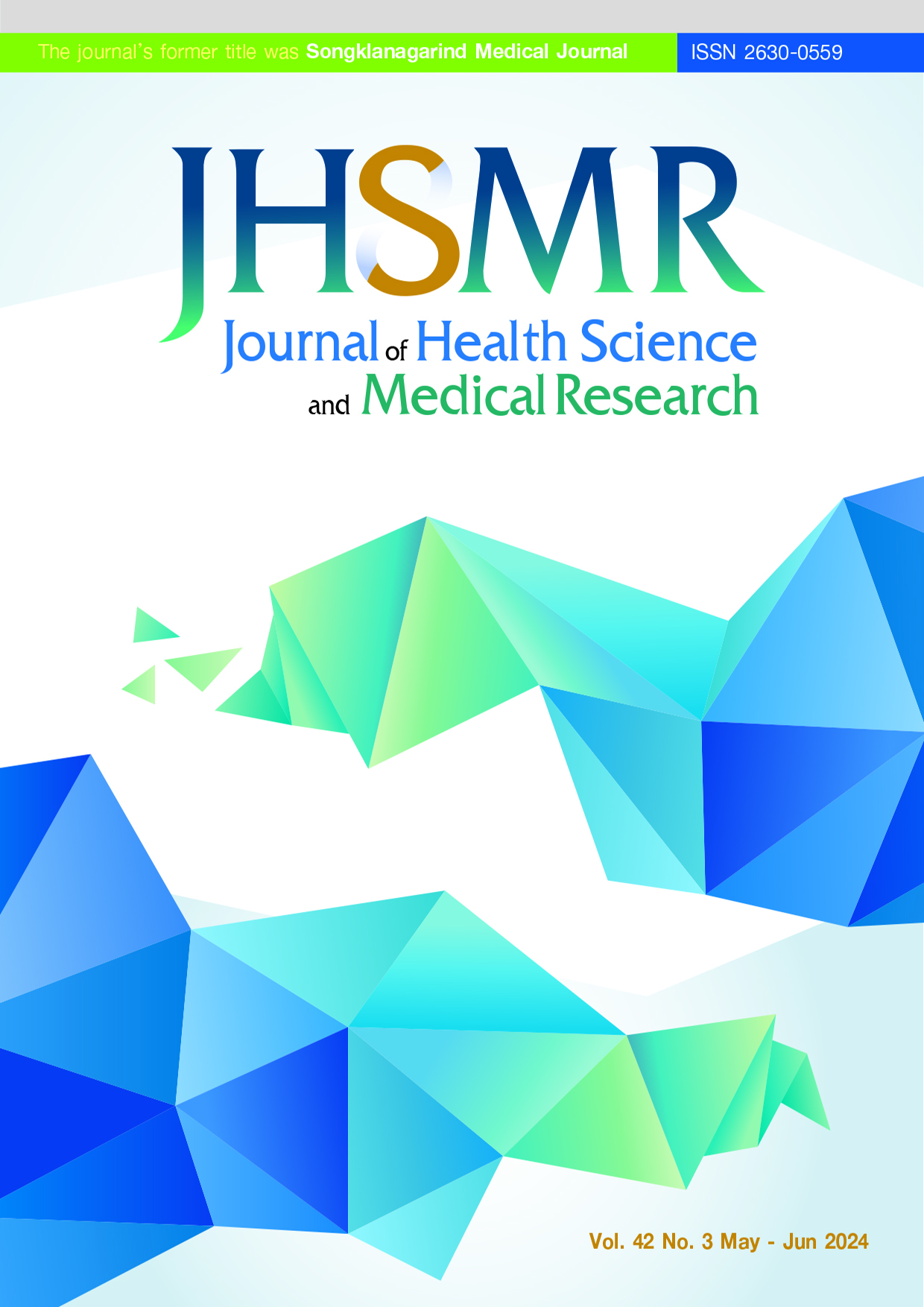Evaluation of Safety of Spinal Anaesthesia in Patients Receiving Perioperative Antithrombotic Therapy Undergoing Infrainguinal Revascularisation Surgeries: A One-Year Prospective Clinical Research
DOI:
https://doi.org/10.31584/jhsmr.20231021Keywords:
antithrombotics, heparin, peripheral artery disease, revascularisation, spinal anaesthesia, UFHAbstract
Objective: To evaluate anaesthetic outcome, patient outcome and timing of perioperative antithrombotic therapy in relation to intrathecal injection in patients undergoing infrainguinal revascularisation surgery, for peripheral artery disease (PAD) in spinal anaesthesia.
Material and Methods: A one-year prospective observational study was conducted; from May 2019 to May 2020, in a tertiary care centre. This included all consecutive patients undergoing infrainguinal revascularisation surgery for PAD under spinal anaesthesia. Preoperative antithrombotics were stopped, as per standard guidelines, to achieve a normal coagulation profile before spinal anaesthesia. Perioperative data related to the patients, antithrombotics, anaesthesia, surgery, and complications were recorded. Primary outcomes measured were anaesthetic outcome in terms of spinal success and spinal safety. Secondary outcomes measured were timing of perioperative antithrombotic therapy in relation to intrathecal injection and patient outcomes defined as: good, morbidity or mortality.
Results: A total of 102 patients were evaluated, with a mean age of 54.69±16.36 years (91% males, 9% females): 58% had medical comorbidities. A single dose of intravenous (IV) unfractionated heparin (5,000-7,500 IU) was given intraoperatively at 24.97±3.69 minutes after intrathecal injection. Anaesthetic outcome was good in all patients; in terms of spinal safety (100%), as none of the patients developed spinal related complications. All had spinal success (100%), as no patient required conversion to general anaesthesia. Postoperatively, 98% (100) of patients had good outcomes, and mortality only occurred in 2% (2) of patients.
Conclusion: Spinal anaesthesia is safe and effective for infrainguinal revascularisation surgery. If the patient has a normal preoperative coagulation profile, and the timeline to stop antithrombotic therapy is strictly followed, administration of IV unfractionated heparin (5,000-7,500 IU); at approximately 25 minutes after intrathecal injection, was found to be safe.
References
Vartanian SM, Conte MS. Surgical intervention for peripheral arterial disease. Circ Res 2015;116:1614-28.
Horváth L, Németh N, Fehér G, Kívés Z, Endrei D, Boncz I. Epidemiology of peripheral artery disease: narrative review. Life (Basel) 2022;12:1041.
Eagle KA, Berger PB, Calkins H, Chaitman BR, Ewy GA, Fleischmann KE, et al. ACC/AHA guideline update for perioperative cardiovascular evaluation for noncardiac surgery-executive summary: a report of the American College of Cardiology/American Heart Association Task Force on Practice Guidelines (Committee to Update the 1996 Guidelines on Perioperative Cardiovascular Evaluation for Noncardiac Surgery). J Am Coll Cardiol 2002;39:542-53.
Golomb BA, Dang TT, Criqui MH. Peripheral arterial disease: Morbidity and mortality implications. Circulation 2006;114:688-99.
Barbosa FT, Jucá MJ, Castro AA, Cavalcante JC. Neuraxial anaesthesia for lower-limb revascularization. Cochrane Database of Systematic Reviews 2013;7:1-45. doi: 10.1002/14651858.CD007083.pub3.
Bode RH Jr, Lewis KP, Zarich SW, Pierce ET, Roberts M, Kowalchuk GJ, et al. Cardiac outcome after peripheral vascular surgery. Comparison of general and regional anesthesia. Anesthesiology 1996;84:3-13.
Pierce E, Pomposelli FB, Stanley GD, Lewis KP, Cass JL, LoGerfo FW, et al. Anesthesia type does not influence early graft patency or limb salvage rates of lower extremity arterial bypass. J Vasc Surg 1997;25:226-33.
Singh N, Sidawy AN, Dezee K, Neville RF, Weiswasser J, Arora S, et al. The effects of the type of anesthesia on outcomes of lower extremity infrainguinal bypass. J Vasc Surg 2006;44:964-70.
O’Toole DP, Cunningham AJ. Regional anesthesia for major vascular surgery. Yale J Biol Med 1993;66:447-56.
Wiersema AM, Watts C, Durran AC, Reijnen MM, van Delden OM, Moll FL, et al. The use of heparin during endovascular peripheral arterial interventions: a synopsis. Scientifica (Cairo) 2016;2016:1456298.
Horlocker TT. Regional anaesthesia in the patient receiving antithrombotic and antiplatelet therapy. Br J Anaesth 2011;107 (Suppl 1):i96-106.
Horlocker TT, Vandermeuelen, E, Kopp SL, Gogarten W, Leffert LR, Benzon HT. Regional anesthesia in the patient receiving antithrombotic or thrombolytic therapy: American Society of Regional Anesthesia and Pain Medicine Evidence-Based Guidelines (Fourth Edition). Reg Anesth Pain Med 2018;43:263-309. doi: 10.1097/AAP.0000000000000763.
Foley TR, Waldo SW, Armstrong EJ. Antithrombotic therapy in peripheral artery disease. Vas Med 2016;21:156-69.
Weerasekera A, Gambhir RP. Antithrombotics in vascular surgery: current practice guidelines. Indian J Vasc Endovasc Surg 2017;4:85-91.
Brogneaux C, Sprynger M, Magnée M, Lancellotti P. 2011 ESC guidelines on the diagnosis and treatment of peripheral artery diseases. Rev Med Liege 2012;67:560-5.
Christopherson R, Beattie C, Frank SM, Norris EJ, Rock P, Parker SD, et al. Perioperative morbidity in patients randomized to epidural or general anesthesia for lower extremity vascular surgery. Anesthesiology 1993;79:422-34.
Goyal VD. Early intervention is an important factor in reducing mortality and morbidity after embolectomy/ thrombectomy for acute limb ischemia. Indian J Vasc Endovasc Surg 2015;2:148-151.
Fraser K, Raju I. Anaesthesia for lower limb revascularization surgery. BJA Education 2015;15:225-30.
Cook PT, Davies MJ, Cronin KD, Moran P. A prospective randomized trial comparing spinal anaesthesia using hyperbaric cinchocaine with general anaesthesia for lower limb vascular surgery. Anaesth Intensive Care 1986;14:373-80.
Zisman E, Erport A, Kohanovsky E, Ballagulah M, Cassel A, Quitt M, et al. Platelet function recovery after cessation of aspirin: preliminary study of volunteers and surgical patients. Eur J Anaesthesiol 2010;27:617–623.
Vandermeulen EP, Aken HV, Vermylen J. Anticoagulants and spinal-epidural anesthesia. Anesth Analg 1994;79:1165-77.
Hyderally HA. Epidural hematoma unrelated to combined spinalepidural anesthesia in a patient with ankylosing spondylitis receiving aspirin after total hip replacement. Anesth Analg 2005;100:882-3.
Ghanami RJ, Hurie J, Andrews JS, Harrington RN, Corriere MA, Goodney PP, et al. Anaesthesia based evaluation of outcomes of lower extremity vascular bypass procedures. Ann Vasc Surg 2013;27:199-207.
Charoensin C, Srichai R, Ingviya T. Vascular complications from coronary angiography/percutaneous coronary intervention: comparing day case patients and inpatients in a tertiary hospital in thailand: a retrospective cohort study. J Health Sci Med Res 2020;38:203-12.
Downloads
Published
How to Cite
Issue
Section
License

This work is licensed under a Creative Commons Attribution-NonCommercial-NoDerivatives 4.0 International License.
























